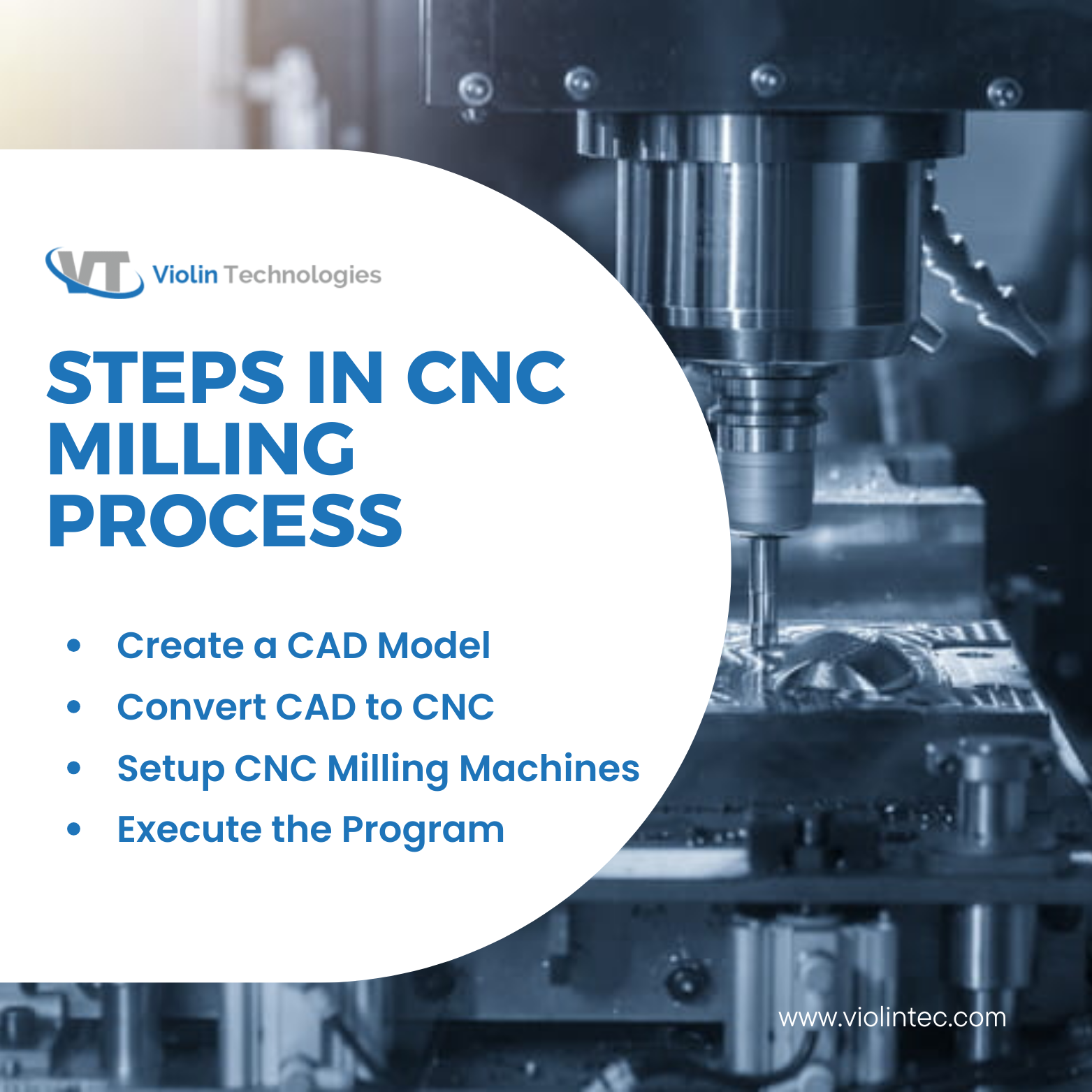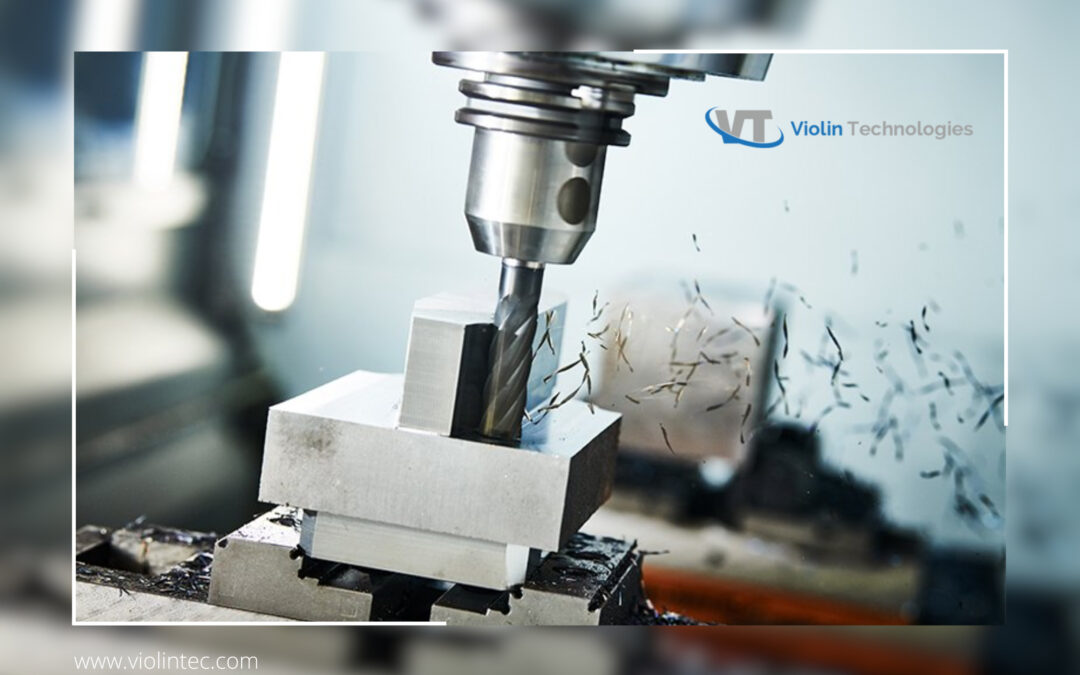Key Takeaways
- CNC milling is precision machining using computer-controlled tools for intricate part production.
- Essential in automotive and aeronautics, CNC milling offers versatile material compatibility.
- CNC-milled parts boast high tolerance levels, ensuring consistency and quality in finished products.
- Versatile and precise, CNC milling shapes workpieces with exceptional accuracy for diverse applications.
What Is CNC Milling?
CNC Milling, aka Computer numerical control milling, is a computer-controlled procedure that uses a cutting tool to remove a portion of a workpiece. The basic setup entails placing the workpiece on the machine’s table while the cutting tool(s) attached to the spindle spins and moves to shape the workpiece into the completed product.
The cutting tool’s rotation and movement are determined by the type of CNC milling machine and its complexity level. This method is extremely adaptable and works with a wide range of materials, including metal, plastics, wood, and glass.
Milling Machine Components
The CNC milling machine consists of several key components: the knee, column, saddle, worktable, spindle, arbor, and machine tool.
- Knee: Supports the saddle and worktable and can be adjusted on multi-axis milling machines
- Column: The primary support structure
- Saddle: Moves parallel to the spindle axis
- Worktable: Where the workpiece is secured
- Spindle: Holds the machine tool or arbor and is powered by an electric motor.
- Arbor: Allows the mounting of multiple machine tools and is found in horizontal milling machines.
- Machine tool: Component responsible for removing material from the workpiece.
Precision machined components manufacturers design high-quality CNC-milled components as per the requirement.

Steps In the CNC Milling Process
CNC milling uses digital controls to run and instruct machine tools that cut and shape stock material. To be precise, CNC milling consists of four steps:
Create a CAD Model
At first, a blueprint of the desired shape is created using CAD (Computer-Aided Design) software that assists in designing a 2D or 3D model of the final product.
Convert CAD to CNC
The CNC machine will not recognize the model you create unless it is in a compliant CNC machining file format. As a result, your CAD model must be exported into CNC-compatible file formats using CAD/CAM software.
After conversion, the file will instruct the machine on the rotational and linear movement, cutting sequence, toolpath, machine, and workpiece speeds connected with the operation.
Setup of CNC milling machines
Before running the CNC program, the operator prepares the CNC milling machine by connecting the workpiece to the machine’s work surface (worktable) or work holding device (vise), as well as attaching the cutting tools to the machine spindle.
The CNC milling makes use of horizontal milling or vertical CNC-enabled milling machines, depending on the milling application’s specifications and needs, as well as spinning multi-point (i.e., multi-toothed) cutting tools such as mills and drills.
Execute the program
After setting up the machine, the operator can initiate the CNC machine program. The entire milling process will then be carried out automatically. Once the execution of the milling part is complete, the machine will create the required part.
Contract manufacturers have the expertise to provide the necessary guidance to the CNC Milling services.
Types Of CNC Milling Operations
Plain Milling
Also known as surface or slab milling, this is a type of milling operation in which the cutting tool’s axis of rotation runs parallel to the workpiece’s surface. The procedure makes use of plain milling cutters with teeth on the edges that execute the cutting action.
Form Milling
Form milling refers to milling procedures that involve uneven surfaces, curves, and outlines, such as pieces having both curved and flat surfaces or totally curved surfaces. This method is commonly used to create hemispherical and semi-circular cavities, beads, and curves, as well as detailed patterns and complicated pieces, all using a single machine setting.
Face Milling
Face milling describes milling processes in which the cutting tool’s axis of rotation is perpendicular to the workpiece’s surface. Face milling cutters are utilized in the process, with teeth on both the perimeter and the tool face, with the peripheral teeth typically used for cutting and the face teeth for finishing applications. Face milling is commonly used to generate smooth surfaces and shapes on completed pieces, and it may provide higher-quality finishes than other milling methods.
Angular Milling
It is the process of milling flat surfaces using a cutting tool at an angle. The method is similar to ordinary milling, with the only variation being the angled configuration.
There are two types of cutters in angular milling machines: single and double angle. Single-angle cutters feature teeth on the angular face and broad flat sides, making them appropriate for working at angles of 45° or 60°. Double angular cutters feature V-shaped teeth with conical surfaces and are better suited for cutting flat surfaces at 45°, 60°, and 90°.
Some of the other types of milling operations are gang milling, straddle milling, and profile milling.
A contract manufacturing company in Chennai provides the best CNC milling services and supplies the necessary parts for specific milling needs.
Conclusion
CNC machining tools cut with high precision, directed by a computer program. Components can be composed in high volume with consistent quality and finish, suitable for complex applications. The process of CNC milling is cost-effective, saves time, and ensures operational efficiency and faster product-to-market delivery.
FAQs
What is the most commonly used cutting tool in CNC applications?
The end mill is the most commonly used cutting tool in CNC applications. Its versatility and easy utilization make it an excellent choice for machining operations with various machine tools, delivering reliable results every time.
What is the cost of CNC milling operations?
Multiple factors affect the cost of CNC milling, including raw materials, part design, production volume, post-processing, and the type of milling machine used. Each of these stages plays a vital role in determining the overall cost of your CNC milling project.
What is the difference between turning and CNC milling?
CNC milling rotates the cutting tool across a stationary workpiece to shape the workpiece, while CNC turning rotates the workpiece to shape it using a stationary cutting tool.

Aparna Sushumna
About the Author
Aparna Sushumna, a mother to a hyperactive toddler who is all over the house. I aspire to be a decent content developer. A Bachelorette of technology says my qualification but I anticipated being a singer. Thanks to the recession, I dwelled into various jobs, from coding to being a tech support executive to a help desk professional, only to conclude that there is something else I wish to do. Here I am to accomplish my profound passion for content writing. Music, nature, jewelry, beauty, mythology, life quotes, celebs, and their life, being my areas of interest.

